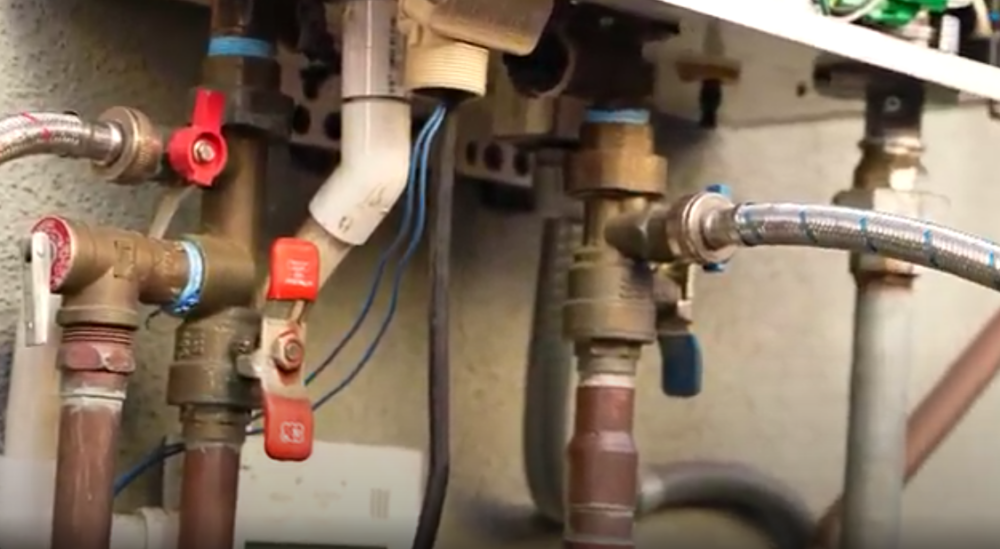
Your tankless water heater is acting up like a toddler who hasn’t had a nap. One day the pressure is temperamental. The next day the temperature is off. You’re left thinking, “what the heck is going on”?
If you call the manufacturer and tell them about the frustrating situation, they’ll probably tell you your tankless water heater needs maintenance. But to do that important maintenance, you’re going to need isolation valves.
After 14 years in the business, we’ve worked with every type of plumbing valve, and we believe that you can be your home’s resident plumbing expert (with a bit of help). We’ve also seen firsthand why isolation valves are essential for your tankless water heater, and we want to pass that knowledge on to you.
By the end of this article, I promise you’ll know what isolation valves are, how they work, and what happens if you don’t have them. I’ll also discuss some common isolation valve questions and next steps so you know why it’s critical to have correctly installed isolation valves.
What Are Isolation Valves for my Tankless Water Heater?
Isolation valves are brass or stainless steel devices that isolate a tankless water heater from the rest of your home’s plumbing system for internal maintenance purposes.
But what the heck does that really mean? It means these valves make your tankless water heater go “offline” from your plumbing system for a bit while you drain and flush it. Meanwhile, you can still use your cold water.
Isolation valves are only for internal tankless maintenance, so they are also called:
- Service valves
- Maintenance valves
- A flush kit
These valves differ from shut-off valves by having a drain and cap. This drain allows you to empty your tankless water heater and run a cleaning solution through it. Shut off valves just stop and start water flow.
You can easily find your isolation valves connected to your tankless water heater, and they are often marked with blue and red for your cold and hot water lines.
How Do Isolation Valves Work?
Isolation valves have a mechanism called a ball valve. A ball valve mechanism has a ball with a hole inside it and an O ring to seal it. When you turn the valve handle 90 degrees to the waterline, the ball rotates and blocks water flow. An easy way to explain it is like this:
Think of the ball as a giant bead and the water as a thread. If you turn the hole away from the thread a quarter turn, you won’t be able to stick the string through.
What Happens if You Don’t Have Isolation Valves?
Since isolation valves are sold separately from tankless water heaters, some plumbers may not include them. If you don’t have isolation valves, you can’t do the necessary yearly maintenance recommended by your manufacturer. Without that maintenance, your tankless water heater could:
- Lose efficiency
- Stop producing hot water
- Get pinhole leaks
- Breakdown early
Hard water buildup causes tankless water heater issues, so it’s essential to maintain your water heater every year. If you realize you don’t have them, call a plumber to get them installed.
What If You Have Supply Hoses Instead?
If you have supply hoses instead of isolation valves, you’ll want to call a plumber and get them replaced. Think of isolation valves as strong pipes with an access point. When they are not used for maintenance, they act as regular pipes to get water into and out of your water heater.
On the other hand, supply hoses are made of thin, braided material that can break with daily wear and tear. Since your tankless water heater will be separated from your water supply when you use it, supply hoses are okay to use for maintenance.
What if Isolation Valves Are Installed Incorrectly?
If your isolation valves are installed incorrectly, you won’t be able to flush your tankless water heater. Your isolation valves can be incorrectly installed if they’re:
- Installed in a way that you can’t access them
- Installed upside-down
Both situations are not good, but if you try to maintain your tankless water heater with upside-down isolation valves, you will end up running a cleaning solution through your home instead of your tankless water heater. Doing this will damage your plumbing system.
To avoid this, make sure you work with certified plumbing professionals.
Next Steps in Your Isolation Valve Journey
Isolation valves are essential pieces of equipment to keep your tankless water heater in excellent working condition because they allow you to maintain it to the manufacturer’s specifications. Now that you know this, what do you do with this information?
You can now maintain your tankless water heater yourself or get a plumber to do it for you. Read more on why maintenance is essential and the steps to take to flush your tankless water heater.
- 2 Types of Tankless Water Heater Maintenance: Why They’re Important
- Hard Water: What It Is and What It Does to Your Home
- The 4 Steps To Flushing a Tankless Water Heater
And if you want us to take care of your tankless maintenance, or you need isolation valves installed, call us at (818) 213-1773 or schedule with our online Scheduler.
